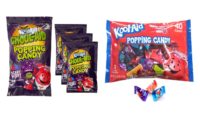Rite Aid's Candy Reel
By Renee M. Covino
The nation's third-largest drug chain is on an accelerated growth plan to operate approximately 5,000 stores, each with a sweet traffic lure.
In the Retail Drug Arena, There’s Been a Buzz of Excitement Surrounding the Pending Jean Coutu Group Acquisition of all Brooks and Eckerd Stores by Rite Aid, a Move That Will up the Total Store Count to Approximately 5,000, Thereby Giving it Greater Scale Comparable to its Major Competitors. the Camp Hill, Pa.-based Chain is Predicted to Have Greater Industry Appeal, With Significant Cost Efficiencies Expected in Merchandising, Purchasing, Advertising and Distribution.
Meanwhile, customers will be drawn to continually
improved services and greater product values, with the sweetest hook of all
— candy. “Unlike our competitors, we view candy as a traffic
category, it is not what we refer to as a margin category,” says Rod
Kautz, vice president of category management for Rite Aid. “The way
we look at it, candy has a great impact in terms of market basket and
footsteps. We use it to draw more people into the store; you can see that
by our price points.”
Actually, customers are seeing more of candy in general
at Rite Aid, thanks to some department shifts and continual evaluations of
the mix. For one, the dedicated candy space has been moved to the
front-left of the store in the chain’s newest Customer World
prototype stores (see sidebar on page 13), rather than to the back of the
store in the food mart layout, as was the previous plan for the category.
Then throughout the store, candy is merchandised on
many endcaps as a lure into other areas. “We try and promote several
front-end presentations of candy that lead into the seasonal aisles; we do
a Russell Stover endcap in the card department to draw customers into that
section,” maintains Kautz. Some candy is merchandised at the
front-end checkout, and some is merchandised at the pharmacy (mostly gum
and mints but also some chocolates such as changemakers from Ghirardelli).
And actually, “gum and mints can be found all over the store,”
according to Kautz.
The rite sweet stuff
Perhaps the most important piece to the chain’s
candy allure is that “as the category has grown and continues to
grow, we make adjustments in our assortment,” says Kautz. While Rite
Aid sets one primary planogram annually, it conducts regular updates
throughout the year, making adjustments wherever and whenever necessary.
“We are constantly reviewing industry numbers
from Nielsen, IRI; we evaluate our displays and merchandise assortments, we
want to bring in what customers are looking for,” Kautz explains.
Unique holiday offerings are part of that equation. Sometimes, new items
necessitate monthly updates for Rite Aid to stay on top of its candy SKUs.
This approach has led to some of the most recent
successes in the category. “The new premium candies are doing great
— that includes Ghirardelli, Dove, Lindt, Hershey, just about
everybody,” according to Val Stansfield, category manager for candy
at Rite Aid. “We promote them in ads, on side-wings for off-shelf
displays, and we feature them through temporary price reductions.”
Theater box candy is another “hot category, as
it is in the drug trade,” says Stansfield. The Rite Aid way of
merchandising it is to “bring it all together in a four-foot section
with gravity-feed displays that keep the boxes merchandised to the front of
the rack,” she says. Once a year, usually in the summer,
“theater-box-style candy” is signed as such and promoted
off-shelf. “We’ve also done side-wings to get an additional
lift when [theater boxes are] on promotion in our circulars, which
currently is every six to eight weeks,” according to Stansfield.
An expanded presence of sugar-free gums in the
multi-pack section of the basic candy planogram is another positive result
of recent confectionery evaluations at the chain. “This has been a
huge success for us,” says Stansfield. “We reviewed the whole
gondola of laydown bags and made room for the sugar-free gum packs
there.”
But that’s not the extent of Rite Aid and
sugar-free. “Healthier candy, including functional, organic and no
sugar” are continually being evaluated by the chain, according to
Kautz. “As everybody jumps into this whole segment, the challenge for
Val and me is to sort through the offerings and determine which suppliers
have staying power in the category.”
In tune with a growing drug chain image, Rite Aid has
made “a serious commitment to patient health and wellness — we
have health platforms year-round,” Stansfield explains. Programs and
product offerings go hand-in-hand to “help our customers lead healthy
lives,” she says. As one example, Rite Aid has taken a health stand
on diabetes and partnered with the American Diabetes Association (ADA) in
fundraiser programs, educational materials and even in the promotion of
appropriate candy products.
But that’s not to say that prescription
customers and/or seniors are the chain’s sole candy focus. “We
go after the kid’s market with kid candy merchandised in a four- to
eight-foot section in the candy gondola and also at the front-end,”
Stansfield explains. “Moms are our key customers, so we try to cater
to her in regard to different types of chocolate. We also are attentive to
portion control offerings — so we try to cover everybody.”
“It’s a fine line sometimes,” Kautz
adds.
Fine-tuned SKUs
And therein lays the flip side to wanting to keep up
with hot new confectionery SKUs, or any new SKUs, for that matter. Rite Aid
is concerned about SKU proliferation. “We found that if you have
that, the productivity of the department goes down versus going up,”
says Kautz.
Instead, “We’re looking for truly unique
items versus just another size or flavor,” explains Kautz. “We
want to see a new item bring value to the category. The way we measure is
to evaluate if it grew the category. Did it have significant impact for the
category and for Rite Aid?”
Because true innovation is so important to the
company, Rite Aid strives to maintain good vendor relations, whether the
manufacturer is a large company or small. “Some of our best vendors
are those that when they come in, they know the account, they’re
prepared, they pay attention to detail, they know the facts and can back
them up, should they be challenged,” says Kautz. “It’s
important to us to exchange information and ideas with our
vendors.”
In addition to always looking for unique innovation,
the chain also evaluates aspects of the candy category that are not what
they once were. “Currently, one of the most challenging areas is
boxed chocolates,” maintains Stansfield. “With premium
chocolates and so many new items that can be conveyed as gift chocolates,
the whole boxed chocolate category is dramatically different from the past.
At one time it was always boxed chocolates that customers wanted as gift
candy. Now, for the industry, we need to make sure we have the variety of
candy items our customers are looking for. The category has grown
tremendously and we need to be on the cutting edge.”
And that goes back to the constant review the chain
employs with the category. “We can’t afford to have slow-moving
products,” affirms Kautz. “There are different criteria we use
to evaluate different types of candy, but overall, we want to turn candy to
always maintain that freshness element. We want to make sure we’re
maximizing our products in the space we’ve allotted, in addition to
continually satisfying our customers.”
Merger in the Making
In August, Rite Aid announced a deal worth
about $3.4 billion to buy the Eckerd and Brooks drugstore chains from their
Canadian parent, the Jean Coutu Group.
The deal will make the Jean Coutu Group the
largest shareholder of the new company with about a 32 percent stake.
The move will give Rite Aid 5,000 U.S. stores,
with locations on both the East and West coasts.
It will also give Rite Aid scale comparable to
its major competitors, Walgreens and CVS.
Rite Aid will drop the Eckerd and Brooks
brands and use the Rite Aid name on all the stores being purchased.
Retail analysts say that the most important
aspect of the deal is that it gives Rite Aid the ability to expand its
footprint nationally while becoming more cost-efficient.
In a conference call with analysts, Rite Aid
CEO Mary Sammons said the deal would enable the company to "compete
effectively in a very competitive business."
About 70 percent of the Eckerd and Brooks stores are located in 14
states where Rite Aid already does business. Additionally, the company will
now have acquired locations in Massachusetts, Rhode Island, South Carolina
and North Carolina.
Rite Aid said the deal is expected to close in
the fourth quarter of its current fiscal year.
The company also
maintained its current fiscal full-year guidance; Rite Aid expects sales to
be between $17.4 and $17.6 billion.
Same-store sales
are expected to increase 2 percent to 4 percent for the fiscal year.
A “World” of Difference
It makes for a more customer-friendly Rite Aid.
It’s upgraded and “open-aired” with much more natural
light. It’s the new Customer World prototype design — slated
for 125 new and “relocated” Rite Aid stores this fiscal year.
The chain plans to open 800 to 1,000 new and relocated Customer World
stores by the end of its fiscal 2010. Created using feedback from customer
focus groups, the design is Rite Aid’s first new prototype in eight
years.
Generally speaking, aisles are wide and clutter-free.
Signage is clear and informational. Shelving is low. Floor displays are
kept to a minimum. The idea is to allow customers to see everything from a
walk around the perimeter (or “around the world”), always
knowing where they are in relation to the key departments.
Because customers expressed that their relationship
with the pharmacist was very important, Rite Aid stores under this new
format highlight the pharmacy, making it the “star” of the
Customer World design.
But beyond that, attention has been paid “to
every merchandising detail in an effort to enhance the customer’s
shopping experience,” according to a recent company release.
What’s more, “product adjacencies are logical” because
“research shows when a customer buys a certain item they will often
purchase another item with the first.”
Rite Aid’s merchandising team has taken this
into consideration when positioning items and adjacencies so that customers
will readily be able to find them. New graphic communications have also
been positioned on shelves to assist customers in their selection process.
The idea is to help customers quickly locate what they came in for; thereby
allowing them more time to browse and impulse-shop other items — a
snack and a soda, perhaps?



